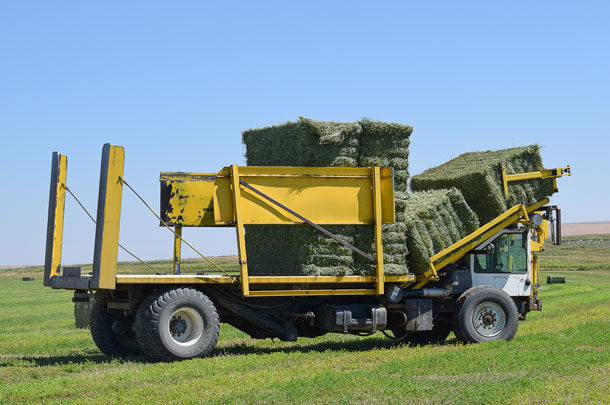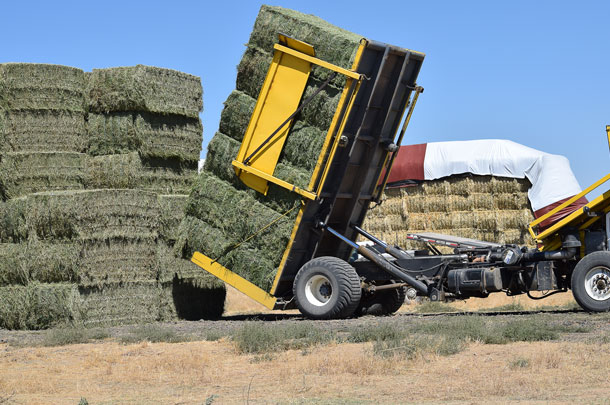“We’ve used a six-bale trailed stacker in the past, but I wanted a 12-bale truck to cut time and free up the tractor,” Berens explains. Berens built his first modified stacker in 2005, with an improved second model leaving his workshop in 2007. “The design is somewhat unique, like the fact it can tip all 12 bales at once, but I did pick and choose a number of features from other machines,” he says.
Alongside his own 250 acres of hay fields, Berens also runs a custom-harvest business with three balers, a rake and two modified bale stackers. Most of his customers supply hay to dairymen in the local region, although he also harvests hay for the Anderson Hay Company to export.

Design
The base of the ’07 model is from an International, mid-80s, S-line truck. Berens removed the tandem axle and installed a single heavy-duty axle. “This left more space to move the engine to the center of the table,” Berens says.
The engine’s central position provides the benefit of better traction when the stacker is empty. However, as the engine was now too far away from the front radiator, an accessory-fan drive was needed to link the central engine to the radiator at the front. “I guess I moved things around until they worked just right,” Berens says. He also installed an air-dampened feature to the hydraulic moving parts. “The dampener prevents the bales from landing on the deck too fast and causing damage,” he says.
The modified stacker works by lifting a single bale of hay with the two front squeeze arms. From here, the bale is lifted, rotated 180 degrees and dropped on the table above the cab. This table tilts up to slide the bale onto the main bale deck in an upright position. Side panels prevent the bales from falling off the deck. The entire bale deck can then be raised more than 90 degrees to tip and stack the bales.
Education
Highly skilled engineers usually carry out the design and manufacture of moving equipment, but Berens praises his early education for his success.
“I took some geometry and shop classes in high school, and after that, I attended the school of hard knocks. My geometry study was especially useful when designing the relationship of the lift arms.”
An interesting feature of the stacker is the centrally located hydraulic valves. A multi-stack valve unit from an old garbage truck was placed under the main bale deck. “This feature prevents excess heat building up in the cab, and it also means I can use switches instead of levers to work the hydraulics,” Berens says.
The hydraulics are controlled via electric-powered toggle switches on the cab’s armrest. A single switch can control the entire lift arm process. As a safety feature, the arms can only rise when the receiving table is in the correct lowered position. “I did that for a reason too, after I dropped a few bales on the cab of the old truck. A big bale stuck on the cab is not a pretty sight!” he says.

Output
Last season, Berens had the ultimate test when working alongside a $200,000 bale stacker. He proudly claims his machine was more than able to keep up with the commercial model. “In general, output depends on the field size, the yield and the location of the yard. In a good day, I can clear 250 acres,” Berens says.
Maintenance of the modified stackers has proved relatively simple for Berens. “Apart from the odd small crack that needs welding, the main job is blowing out the dust in hot weather,” he says.
Overall, the entire build cost $25,000 dollars, including locally sourced steel and Berens labor costs. “We insured it for that value based on the amount of work it does, but it’s a heck of a saving on a new piece of equipment.”
For Berens, the process isn’t compete yet as he still has further improvements in mind. “I’d like to remove the side panels and add a rolling trolley to the deck instead.” But for now, the improvements will have to wait until the busy hay season is complete. FG
Michael Cox was a 2015 Progressive Forage Grower editorial intern.
PHOTOS: High school geometry and shop classes helped guide Rick Berens in his design of a made-from-scratch bale stacker. Photos by Rick Berens.












